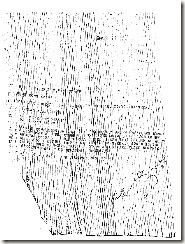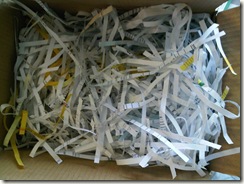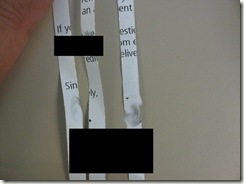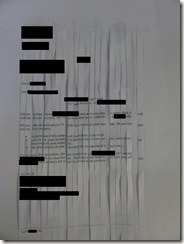Reassembling shredded documents
When the Americans abandoned their embassy in Iran in 1979, they shredded thousands of classified documents with strip-cut paper shredders and left the shreddings behind in garbage bags. The assumption was that the information was secure because it would take half a million people 5 years to put it back together and that it was highly unlikely that anyone would be able to do that.
 So Iran rounded up a whole bunch of carpet weavers (people used to dealing with tangles!), gave them each a roll of sticky tape and a bunch of shredded material. A few years later and they had reassembled most of the classified documents.
So Iran rounded up a whole bunch of carpet weavers (people used to dealing with tangles!), gave them each a roll of sticky tape and a bunch of shredded material. A few years later and they had reassembled most of the classified documents.
And then Iran published them in a series of books called Documents from the U.S. Espionage Den. So much for the US’ secrets.
Since then, more secure shredders have been developed that turn paper into very thin, short strips that mean it’s much harder to put things back together. To reduce the likelihood of someone putting the pieces back together the shreddings can be mixed up. I read somewhere that the CIA learned from what took place in Iran and turns the shreddings into pulp them before burning the pulp.
Fast forward to yesterday:
 I received a parcel in the mail and when I opened the box I found that the shipper had used shredded material instead of packing peanuts, bubble pack or scrunched up kraft paper.
I received a parcel in the mail and when I opened the box I found that the shipper had used shredded material instead of packing peanuts, bubble pack or scrunched up kraft paper.
While digging through it to find what I’d ordered, I noticed that the paper had been shredded by a 1/4” straight shredder. This meant that it was fairly easy to make out what was on the strips, particularly in cases where the paper had been sent through sideways so that the lines of text were aligned along the strips.
 And because the person had grabbed a couple of handfuls from their shredder, strips from the same page tended to be clumped together.
And because the person had grabbed a couple of handfuls from their shredder, strips from the same page tended to be clumped together.
It became clear that the paper wasn’t just boring old printouts that were shredded to use as packing material. Instead, it consisted of credit card statements, bills, health insurance forms and similar stuff that most people wouldn’t throw in the garbage for fear of identity theft.
 With relatively little time and effort, I was able to retrieve enough strips from the same document and reassemble enough of it that I could read a letter advising someone that the limit on their credit card had been raised. Included in the letter was the full card number, though I was missing two digits in the middle of the number. However, given that I had the check digit the number of possibilities for the missing digits would have been fairly limited. And I’m fairly certain that if I’d intensively searched through the box I would have found the missing strip or I would have found the account number on one of the other documents that had been shredded.
With relatively little time and effort, I was able to retrieve enough strips from the same document and reassemble enough of it that I could read a letter advising someone that the limit on their credit card had been raised. Included in the letter was the full card number, though I was missing two digits in the middle of the number. However, given that I had the check digit the number of possibilities for the missing digits would have been fairly limited. And I’m fairly certain that if I’d intensively searched through the box I would have found the missing strip or I would have found the account number on one of the other documents that had been shredded.
Yikes!
Fortunately, I’m not a Bad Guy, so I contacted the shipper and explained the problem to them and suggested that they needed to a) get a better shredder, and b) not use shredded material as packing material. And then I shredded the reconstructed document in a secure shredder and disposed of the remaining shredded material securely. If a Bad Guy had gotten their hands on this material they would have had more than enough information to steal at least one person’s identity, if not more.
So, when you shred something, dispose of the shreddings properly – don’t given them to someone. And be sure you use a cross-cut shredder that cuts things into tiny pieces rather than long strips.
A tip o’ the hat to Wikimedia Commons for the document from the US embassy in Iran.



 AKA Keeper of Maps, I'm a geocacher who lives in Ottawa, Canada.
AKA Keeper of Maps, I'm a geocacher who lives in Ottawa, Canada.

No way!
That’s my credit card number!
(45——-)
😉